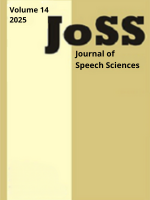Abstract
This paper examines the use of derogatory prefixes and productive compounding as linguistic vehicles of hate speech in German Twitter, with a special focus on ethnic and religious minorities, on the background of the European immigration crisis. The linguistic mechanisms discussed focus on both morphology and semantics and include slur expansion, stereotype-based pseudo-slurs, fusion words, narrative encoding and the use of metaphor, among others. Specifically, we identify and document five main stereotypes for recent Muslim immigrants, as well as the main derogatory narration metaphors used in the German immigration discourse (e.g. disease, disaster, war). We discuss and classify over 500 individual lexical examples and tweet fragments, showing how pejorative word elements (e.g. animal tropes) are amalgamated with target group connotaters to achieve various desired effects, both denotative and connotative, as well as humour-based techniques such as puns, irony and understatement. The work is based on an unabridged, grammatically and semantically annotated 2 billion word Twitter corpus, harvested between 2017 and 2019.
References
1. Baumgarten N., Bick E., Geyer K., Iversen D. A., Kleene A., Lindø A. V., Neitsch J., Niebuhr O., Nielsen R., Petersen E. N. Towards Balance and Boundaries in Public Discourse: Expressing and Perceiving Online Hate Speech (XPEROHS). In: Mey J., Holsting A., Johannessen C., editors: RASK – International Journal of Language and Communication, 2019, vol. 50. University of Southern Denmark. pp. 87–108.
2. Bick E. An Annotated Social Media Corpus for German. In: Calzolari, Nicoletta et al., editors, Proceedings of the 12th International Conference on Language Resources and Evaluation (Marseille, May 2020). ACL / ELRA, 2020. pp. 6129–6137.
3. Bick E. Almans and Kanaks: Inter-cultural Stereotypes in a German Twitter Corpus. In: Mey J.; Holsting A. Johannessen C., editors: RASK - International Journal of Language and Communication, 2011, vol. 53. University of Southern Denmark. pp. 101-117. ISSN: 0909-8976
4. Buerger C., Wright L. Counterspeech: A Literature Review. 2019. Available from: https://dangerousspeech.org/wp-content/uploads/2019/11/Counterspeech-lit-review_complete-11.20.19-2.pdf [accessed 20 May 2020]
5. Dammel A., Quindt O. How do evaluative derivational meanings arise? A bit of Geforsche and Forscherei. In: Finkbeiner R.. Meibauer J., Wiese H., editors. Pejoration, 2016. John Benjamins. p. 43.
6. Finkbeiner R., Meibauer J., Wiese H., editors. Pejoration, 2016. John Benjamins. pp. 2–4.
7. Freywald U., Mayr K., Özçelik T., Wiese H. Kiezdeutsch as a multakiethnolect. In: Kern F., Selting M., editors: Ethnic Styles of Speaking in European Metropolitan Areas. Amsterdam: John Benjamins, 2011. pp. 45–74.
8. Haslam N., Sun P. Beastly: What makes Animal Metaphors Offensive? In: Journal of Language and Social Psychology 2011, 30(3). pp. 311–325.
9. Hudson D. L. Jr. Counterspeech Doctrine. In: Seigenthaler J, editor. The First Amendment Encyclopedia, 2017. Available from: https://www.mtsu.edu/first-amendment/article/940/counterspeech-doctrine [accessed 20 May 2020]
10. Jaki S., De Smedt T. Right-wing German hate speech on Twitter: Analysis and automatic detection. 2019. p. 14. arXiv preprint arXiv:1910.07518
11. Korecky-Kröll K., Dressler W. Expressive German Adjective and Noun Compounds in Aggressive Discourse: Morphopragmatic and Sociolinguistic Evidence from Austrian Corpora. In: Knoblock, N., editor. The Grammar of Hate: Morphosyntactic Features of Hateful, Aggressive, and Dehumanizing Discourse. Cambridge University Press, 2022. pp. 197-221.
12. Magu R., Luo J. Determining Code Words in Euphemistic Hate Speech Using Word Embedding Networks. In: Proceedings of the 2nd Workshop on Abusive Language Online (ALW2, Brussels, Oct. 2018), 2018. pp. 93–100.
13. Meibauer J. Hassrede / Hate Speech – Interdisziplinäre Beiträge zu einer aktuellen Diskussion. Gießen: Gießener Elektronische Bibliotek, 2013.
14. Nann L., Udupa S, Wisiorek A. Online anti-immigrant discourse in Germany: ethnographically backed analysis of user comments. Frontiers in Communication, 9:1355025, 2024. doi: 10.3389/fcomm.2024.1355025
15. Njagi D. G., Zhang Z.; Hanyurwimfura D, Jun L. A Lexicon-based Approach for Hate Speech Detection. In: International Journal of Multimedia and Ubiquitous Engineering, 2015, Vol.10, No.4., pp. 215–230.
16. Malmasi S., Zampieri M. Detecting Hate Speech in Social Media. In: Proceedings of Recent Advances in Natural Language Processing (Varna, Bulgaria, Sep 4–6 2017). 2017. pp. 467–472.
17. Paasch-Colberg S., Trebbe J. Strippel C., Emmer M. Insults, Criminalisation, and Calls for Violence: Forms of Hate Speech and Offensive Language in German User Comments on Immigration. In: Monnier A., Boursier A. Seoane A., editors. Cyberhate in the Context of Migrations. Postdisciplinary Studies in Discourse, 2022. Cham: Palgrave Macmillan. pp. 137-163. DOI: 10.1007/978-3-030-92103-3_6.
18. Sorrentino D. Worte sind Steine: I composti dell’odio in tedesco. Alcuni esempi dai post su Twitter di esponenti del partito Alternative für Deutschland (AFD). L’Analisi Linguistica E Letteraria XXXII, 2024. pp. 55-74. ISSN: 1122-1917. Available from https://www.analisilinguisticaeletteraria.eu/ index.php/ojs/article/view/663/475.

This work is licensed under a Creative Commons Attribution 4.0 International License.
Copyright (c) 2025 Eckhard Bick


